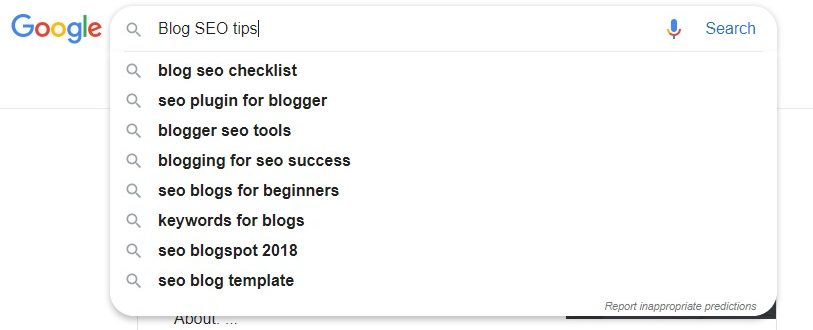Are you looking for result-driven blog SEO tips and strategy? Read on to learn how to write SEO-friendly blog posts.
Having an awesome business blog is a no brainer. Writing your first blog post can be fun and exhilarating. But what if there is no one to read your blog posts? And even if you manage to have a loyal audience, how to keep the number growing is an art. You need a dedicated and consistent content strategy that incorporates result-oriented Search Engine Optimisation practices.
Know the secret nuggets to make it to the top search engine rankings and achieve your marketing goals through professional blog posting.
Why is this important? Content is content, right?
No.
No matter how superb your blog post is, unless it is optimised for search engines as well as the readers, you cannot attain desired results. A well-optimised content designed with readers in mind is a powerful tool to rank higher in SERPs, drive increased traffic, engage your readers, and persuade them to become money-paying customers eventually.
Get actionable blog SEO tips here that can help you optimise your content and make it come into the spotlight.
Top 12 Blog SEO Tips to Optimise Your Content
#1: Kick-start with Effective Keyword Research
“Optimising your blog content begins with careful keyword research. This helps curate your content around what your target audience is genuinely searching for.”
Gone are the days when stuffing as many keywords into the content could fetch you good search engine rankings. Today, it is all about enhanced reader experience. Therefore, in-depth keyword research is vital to figure out the intent of your audiences.
A smart way to do this is to have 1 primary keyword in addition to a few (2-3) secondary (related) keywords. Some popular keyword research tools you can use for the purpose are Soovle, Google Keyword Planner, and KeywordsEverywhere. With the right keywords, it becomes easier to optimise blog content for SEO. Keep in mind that you select keywords with high CPC, medium to low competition, and low-higher volume search per month.
Example:

The numbers in the above image indicate that 210 people per month search for the keyword ‘blog SEO tips’. If you intend to write a blog on this keyword, you will face a competition of only 7%, which is very low. This improves the chances of ranking higher if it offers real value. The Cost-Per-Click for the keyword is USD 1.16.
#2: Do Not Overlook the Power of Long-Tail Keywords to Create an SEO-Friendly Blog
Generally, short-tail keywords with just 1-2 words face high competition. So, they are difficult to rank. Furthermore, search engines give more importance to content that is relevant to the user’s search intent. So, it is advisable to be more specific with your keywords. Take this blog, for example. Using a precise keyword like “blog content strategy” is more relevant to what people would search for as compared to a broad keyword like “blog content.” Moreover, it would be easier to rank for the long-tail keywords as the competition is high for the term “blog content.” Targeting it solely will make the blog get lost in the clutter.
Example:


Keyword research tools, as mentioned in the 1st point, can help choose relevant long-tail keywords. But here’s another simple, practical and quick tip for you, if you have not installed a keyword search tool.
Go to Google Search box and type the topic/keyword that you have in mind. Take for example, “Blog SEO tips” as we have used in our blog. As you type in the search box, Google will show related keyword suggestions, as shown in the image below. These can give you a fair idea of which long-tail keywords you can use in your blog content.

One more Pro Tip You’ll Love: See the searches related to your keyword/topic given at the end of your search results. You’ll see a list of ‘8’ suggestions from Google as common searches relevant to your keyword. You can even optimize your blog with those keywords.
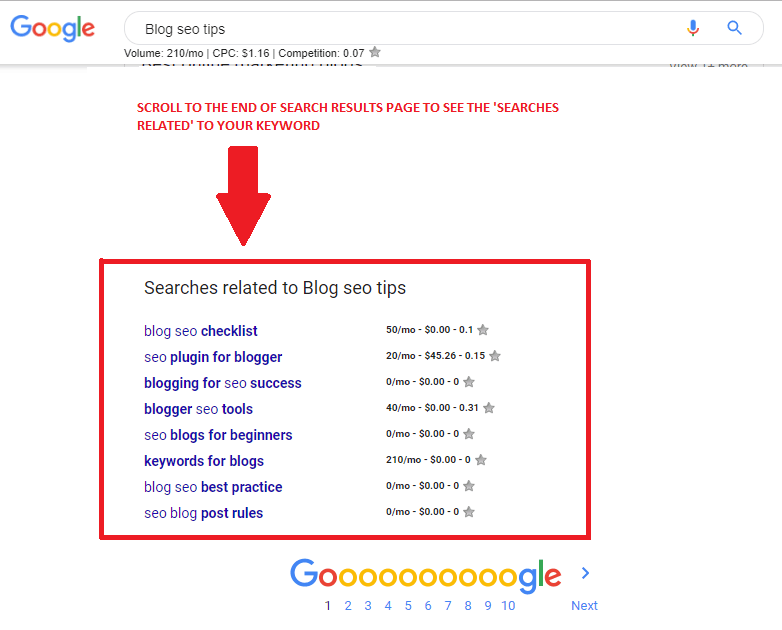
#3: See What Your Competitors are Doing
To optimise blog content for SEO, checking out what and how your competitors are doing is a smart move. Search Google with your target keywords, and you will come across some rich results on the SERPs. Take an idea from competitor pages on how they are using their keywords, the kind of title (title tag) and meta descriptions (meta tags) they have, uniqueness and value in content, use of keywords, placement of keywords, etc. This will help you shape your blog content and optimise it for search engines.
If your search results show up featured snippets as mentioned in the image below or include video thumbnails, images or rich information, then you should strive to optimise the content to be as effective as or better than them.
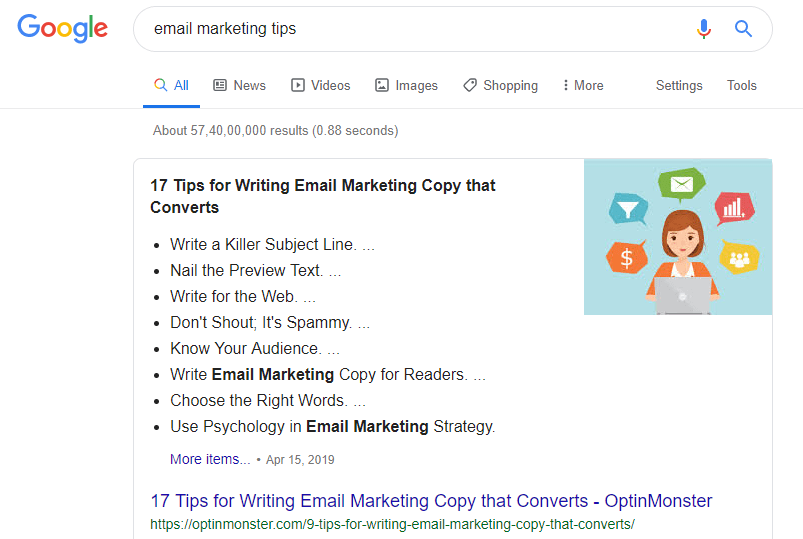
#4: Right Keyword Placement is the ‘Key’
The next and one of the most essential SEO tips for blogs is integrating the keywords appropriately in your content. Instead of stuffing the keywords here and there without making sense, make sure they are naturally blended into the flow of the blog post.
However, there are some key places that can help improve your search engine results.
7 places where your keywords should be used (preferably, but in a sensible manner) are – Title [H1 Tag], URL, Meta Tags (Meta title and description), First 60 words, Last Paragraph, Sub-Headings (also known as H2, H3 Tags) and once in Content Body. Ensure you do not force the keyword usage.
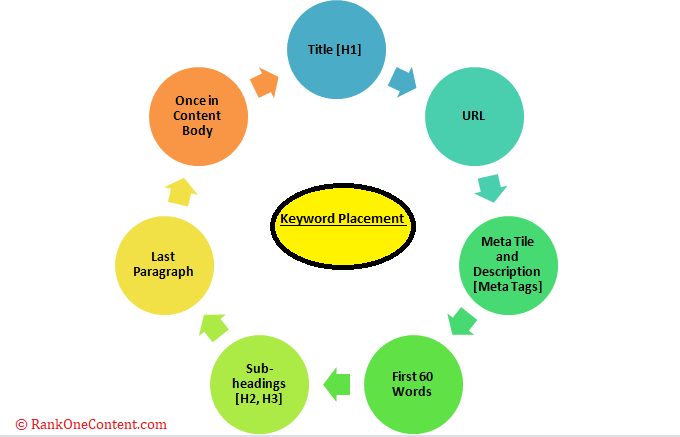
- Title Tag: The title of your blog content is the first thing the search engines and your readers will consider to determine its relevancy. Therefore, including your primary/main keyword in the headline is crucial. For more effectiveness, the keyword should be within the first 60 characters of the title because, after that, Google cuts off the headlines on SERPs.

- URL: Your blog URL is one of the first things search engines crawl on your page to determine what the post is all about. A well-optimised and unique URL with the right keyword placement is a great way to boost your search engine ranking and visibility.
In the below example image, the main keyword “email marketing tips” has been intelligently incorporated in the URL to make it to the top SERP rankings on Google.

- Meta Descriptions: Your meta description provides a gist of your blog content and is a key search engine ranking factor that Google gives much importance to. So, do not miss including your primary keyword along with at least one secondary/related keyword in your meta description.
In the image below, both keywords “email marketing” and “email marketing tips” have been included in the meta description for maximum impact and SERP ranking.

- First and Last Paragraph: Try to incorporate your primary keyword anywhere in the first paragraph, preferably in the initial 60 characters or in the second line. Similarly, it should be there in the concluding paragraph as well, ideally in the last line. Check out how we used our primary keyword ‘Blog SEO tips’ in all the important places.
- Headers and Body: Scatter your keywords in a natural and reader-friendly manner throughout your blog content body – 1 or 2 times. The keywords (main as well as secondary) should also appear in H2 and H3 tags (i.e. sub-heads) to ensure the search engine can crawl it easily.
Search engines do not read the entire blog content. They take up cues from the title, meta description, URL, first and last lines, and subheads. Therefore, positioning your keywords in these places is vital for SEO-friendly blog content strategy.
#5: Meta Description Optimisation
The meta description is a powerful tool to create an impactful first impression. It also influences the click-through behaviour of readers when browsing through SERPs. Therefore, it has to be captivating, engaging, and convincing. Check competitor meta descriptions on Google (the top 3-4 organic results) and try to write something better than theirs in meaning and value.
Don’t you yourself click on results which have the most relevant Meta title and Meta description, when you search for any information, product or service?
We’re sure the answer is ‘A Big Yes’!

Make sure you use the primary keyword as well as one secondary keyword in the meta description (if possible) to make a huge difference in what people choose to click. A meta description preferably should be within 165 characters (inclusive of spaces).
#6: A Blog Title to Impress (The One That People Can’t Resist Clicking)
The attention span of your audience is just 5 seconds. And only a compelling title (preferably short – 65-70 characters, including spaces) can catch their eyes instantly and influence them to click on your search result. While having your main keyword in the title is a must, it should also be able to build an emotional attachment with the readers (at the very first glance).
The title and the blog content should be designed around what your target audiences search the internet for. It should be able to provide a solid answer to their questions or be relevant to their search intent. Buzzsumo is one of the best sources to find title and content ideas that are already popular in your niche and have garnered good response from the readers.
To create title and blog posts that specifically answer your readers’ questions (Example – titles start with ‘How to’ ‘Tips for’ ‘Best Ideas’ ‘Easy Ways’), you can use the search box of a powerful platform – Quora. Simply search with your primary keyword or broad topic on Quora, and you will come across hundreds of reader questions that include the key phrase. From there, you can pick top questions to create your blog titles. The “People Also Ask” section on Google SERPs also gives you a good idea of questions to answer.
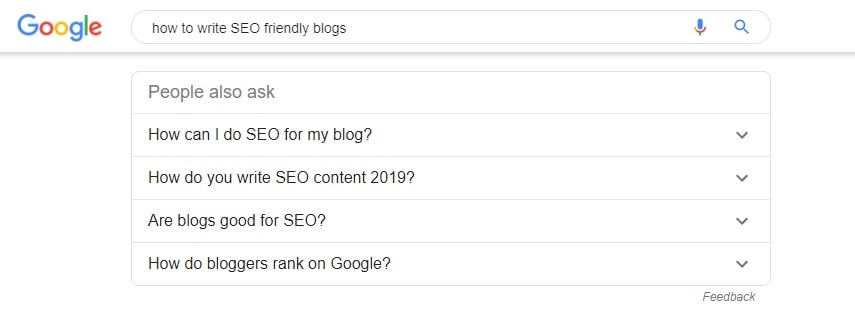
Use power words and emotional words in the title or phrases. These tickle the readers’ emotion and can grab their attention quickly. This would act as a trigger and persuade them to click on the link.
Few examples of click-bait titles that have made it to the top search rankings and garnered more clicks are given herewith:
You can use some top headline analyzer tools to craft a catchy and clever blog post title that inspires remarkable clicks and social sharing.
Pro Tip: Once you have created an attention-grabbing title, check its effectiveness on Headline Analyzer by CoSchedule. Getting a score more than 60-65 ensures you have a title that can drive traffic, boost search results, and increase shares.
#7: Make Your Blog Content Mobile-Friendly
Optimising your blog content for mobile phone users is one of the most important blog SEO tips you should consider. That is because, by the end of 2019, an approximate 63.4% of global mobile phone users will access the web from their smartphones. So the content should be structured and designed in a manner to fit into the small screen size and render a seamless reading experience.
Using small and crisp paragraphs (advisable length 60-75 words or even shorter), bullet points and responsive website design is a great way to make your content mobile-friendly.
#8: Optimising Your Image Alt Text is Vital
Incorporating rich media content, such as images or infographics, into your blog post makes it more reader-friendly and engaging. Search Engine crawlers look for the alt text that comes with the images as a ranking factor for your content. So, it should be well-optimised and should narrate descriptively what the image is all about.
Pro Tip: If a blind person can understand what the image is all about by reading the Alt Text, you’ve done the best job at it. Preferably choose an image in which you can incorporate your main keyword.
If possible, use at least one alt text in your blog content with the primary keyword and/or the secondary keyword to make it more SEO-friendly. Here’s an example of a ‘good’ image alt text format against its ‘okay’ alternative:

#9: Determine Optimum Blog Content-Length
The latest trend is to write long-form content (Hyperlink to blog “How Long-Form Content Can Transform Your Search Engine Visibility) of 1500-3000 words to provide in-depth and immersive reading experience on a particular topic. Search engines love all-inclusive content, and so do your readers. Make sure it is relevant to the topic, has useful information, and captivates your audience with its structure and media content.
In case, for some reason, if you plan to write a shorter blog post, it should be of minimum 300 words. However, if you have no specific reason to write such a short post, prefer at least 500 words. Whatever you write, try to cover it in totality.
#10: Relevant Internal and External Links are a Must for an SEO-Friendly Blog
Quality links are a vital ranking signal and can help build credibility for search engines and your target audience. Internal hyperlinking is a great way to promote and increase the traffic on another blog post that you have already published and is relevant to the one you are writing. If you take Point 9 of our blog as an example, you would see we have linked it internally to another of our blog post “How Long-Form Content Can Transform Your Search Engine Visibility” as that would add value to a reader who intends to know more about ideal blog length.
This not only helps market our earlier blog post effectively but also adds value to our readers. For effective and natural internal linking, use anchor text (keyword) relevant to the target keyword used in the older post.
External linking to educational resources, media platforms, and authority websites can also make your content more SEO-friendly and valuable for your readers. After all, linking to top-ranking, high-authority links is what Google loves! If you go back to Point 7 of our blog, you would see how we have linked the statistics to its source while highlighting the numbers.
#11: Make Sure Your Topic Tags Aren’t Too Similar
If you tend to overuse too many similar-looking topic tags in your blog content, it can send out a message to the search engines that you are trying to show the content numerous times across the website.
For instance, topic tags like ‘blog,’ ‘blog posts,’ or “blogging” are quite similar to one another. Wrong use of tags can cause more harm than good. So make sure you do not overuse related tags. Instead, pick ones that aren’t too similar but are relevant to the content.
#12: The Blog Content should be Plagiarism-free, Grammarly and Hemingway-checked
Last but not the least, to optimise your blog content for SEO, make sure it is 100% plagiarism-free, unique, and original. Check it on dependable tools like Copyscape Premium before you publish because plagiarised content can cause search engines to penalise you.
Additionally, it should be checked on Grammarly and Hemingway App for correct English and high readability. A score with ‘Grade 5’ and ‘Grade 6’ is good. This score indicates minimum use of difficult words, negligible use of adverbs and fillers, short sentences, use of active-voice.
Conclusion
Your blog acts as a powerful SEO and lead-generation tool when optimised intelligently. It can improve your search rankings, boost visibility, and drive increased traffic. Build your blog’s search authority with the above tips and boost your business.
Looking for professional SEO blog writers? Rank One Content provides expert blog writing services, crafting content that is SEO-friendly, engaging, and result-driven. We ensure that we focus on taking your website ranking higher, while you focus on the best aspects of your business.
